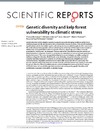Please use this identifier to cite or link to this item:
https://accedacris.ulpgc.es/handle/10553/41420
| DC Field | Value | Language |
|---|---|---|
| dc.contributor.author | Wernberg, Thomas | en_US |
| dc.contributor.author | Coleman, Melinda A. | en_US |
| dc.contributor.author | Bennett, Scott | en_US |
| dc.contributor.author | Thomsen, Mads S. | en_US |
| dc.contributor.author | Tuya, Fernando | en_US |
| dc.contributor.author | Kelaher, Brendan P. | en_US |
| dc.date.accessioned | 2018-06-28T13:13:20Z | - |
| dc.date.available | 2018-06-28T13:13:20Z | - |
| dc.date.issued | 2018 | en_US |
| dc.identifier.issn | 2045-2322 | en_US |
| dc.identifier.uri | https://accedacris.ulpgc.es/handle/10553/41420 | - |
| dc.description.abstract | Genetic diversity confers adaptive capacity to populations under changing conditions but its role in mediating impacts of climate change remains unresolved for most ecosystems. This lack of knowledge is particularly acute for foundation species, where impacts may cascade throughout entire ecosystems. We combined population genetics with eco-physiological and ecological field experiments to explore relationships among latitudinal patterns in genetic diversity, physiology and resilience of a kelp ecosystem to climate stress. A subsequent 'natural experiment' illustrated the possible influence of latitudinal patterns of genetic diversity on ecosystem vulnerability to an extreme climatic perturbation (marine heatwave). There were strong relationships between physiological versatility, ecological resilience and genetic diversity of kelp forests across latitudes, and genetic diversity consistently outperformed other explanatory variables in contributing to the response of kelp forests to the marine heatwave. Population performance and vulnerability to a severe climatic event were thus strongly related to latitudinal patterns in genetic diversity, with the heatwave extirpating forests with low genetic diversity. Where foundation species control ecological structure and function, impacts of climatic stress can cascade through the ecosystem and, consequently, genetic diversity could contribute to ecosystem vulnerability to climate change. | en_US |
| dc.language | eng | en_US |
| dc.relation.ispartof | Scientific Reports | en_US |
| dc.source | Scientific Reports [ISSN 2045-2322], v. 8, article number 1851 | en_US |
| dc.subject | 251001 Oceanografía biológica | en_US |
| dc.subject.other | Habitat-Forming Kelp | en_US |
| dc.subject.other | Physiological-Responses | en_US |
| dc.subject.other | Macrocystis-Pyrifera | en_US |
| dc.subject.other | Genotypic Diversity | en_US |
| dc.subject.other | Species Richness | en_US |
| dc.subject.other | Edge Populations | en_US |
| dc.subject.other | Temperate Reefs | en_US |
| dc.subject.other | Range-Edge | en_US |
| dc.subject.other | Giant-Kelp | en_US |
| dc.subject.other | Adaptation | en_US |
| dc.title | Genetic diversity and kelp forest vulnerability to climatic stress | en_US |
| dc.type | info:eu-repo/semantics/Article | en_US |
| dc.type | Article | en_US |
| dc.identifier.doi | 10.1038/s41598-018-20009-9 | en_US |
| dc.identifier.scopus | 85041352956 | - |
| dc.identifier.isi | 000423508900022 | - |
| dc.contributor.authorscopusid | 8657683700 | - |
| dc.contributor.authorscopusid | 10243113600 | - |
| dc.contributor.authorscopusid | 36092571600 | - |
| dc.contributor.authorscopusid | 7201684589 | - |
| dc.contributor.authorscopusid | 6603608107 | - |
| dc.contributor.authorscopusid | 6602488031 | - |
| dc.identifier.issue | 1851 | - |
| dc.relation.volume | 8 | en_US |
| dc.investigacion | Ciencias | en_US |
| dc.type2 | Artículo | en_US |
| dc.contributor.daisngid | 272528 | - |
| dc.contributor.daisngid | 751790 | - |
| dc.contributor.daisngid | 2771637 | - |
| dc.contributor.daisngid | 461261 | - |
| dc.contributor.daisngid | 308553 | - |
| dc.contributor.daisngid | 404020 | - |
| dc.utils.revision | Sí | en_US |
| dc.contributor.wosstandard | WOS:Wernberg, T | - |
| dc.contributor.wosstandard | WOS:Coleman, MA | - |
| dc.contributor.wosstandard | WOS:Bennett, S | - |
| dc.contributor.wosstandard | WOS:Thomsen, MS | - |
| dc.contributor.wosstandard | WOS:Tuya, F | - |
| dc.contributor.wosstandard | WOS:Kelaher, BP | - |
| dc.date.coverdate | Diciembre 2018 | en_US |
| dc.identifier.ulpgc | Sí | en_US |
| dc.contributor.buulpgc | BU-BAS | en_US |
| dc.description.sjr | 1,414 | |
| dc.description.jcr | 4,011 | |
| dc.description.sjrq | Q1 | |
| dc.description.jcrq | Q1 | |
| dc.description.scie | SCIE | |
| item.fulltext | Con texto completo | - |
| item.grantfulltext | open | - |
| crisitem.author.dept | GIR ECOAQUA: Biodiversidad y Conservación | - |
| crisitem.author.dept | IU de Investigación en Acuicultura Sostenible y Ec | - |
| crisitem.author.dept | Departamento de Biología | - |
| crisitem.author.orcid | 0000-0001-8316-5887 | - |
| crisitem.author.parentorg | IU de Investigación en Acuicultura Sostenible y Ec | - |
| crisitem.author.fullName | Tuya Cortés, Fernando José | - |
| Appears in Collections: | Artículos | |
SCOPUSTM
Citations
172
checked on Jun 8, 2025
WEB OF SCIENCETM
Citations
163
checked on Jun 8, 2025
Page view(s)
66
checked on Sep 23, 2023
Download(s)
96
checked on Sep 23, 2023
Google ScholarTM
Check
Altmetric
Share
Export metadata
Items in accedaCRIS are protected by copyright, with all rights reserved, unless otherwise indicated.
